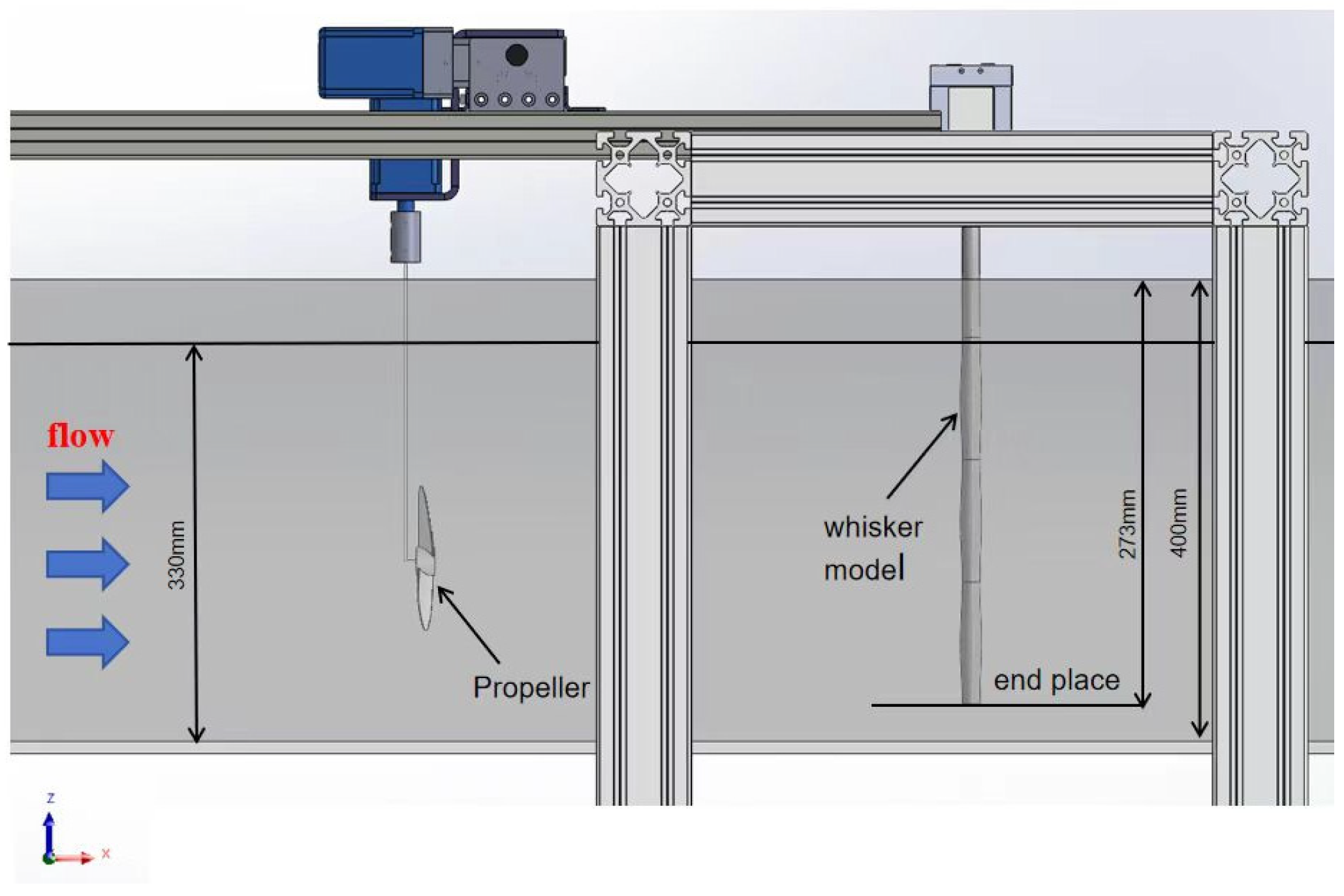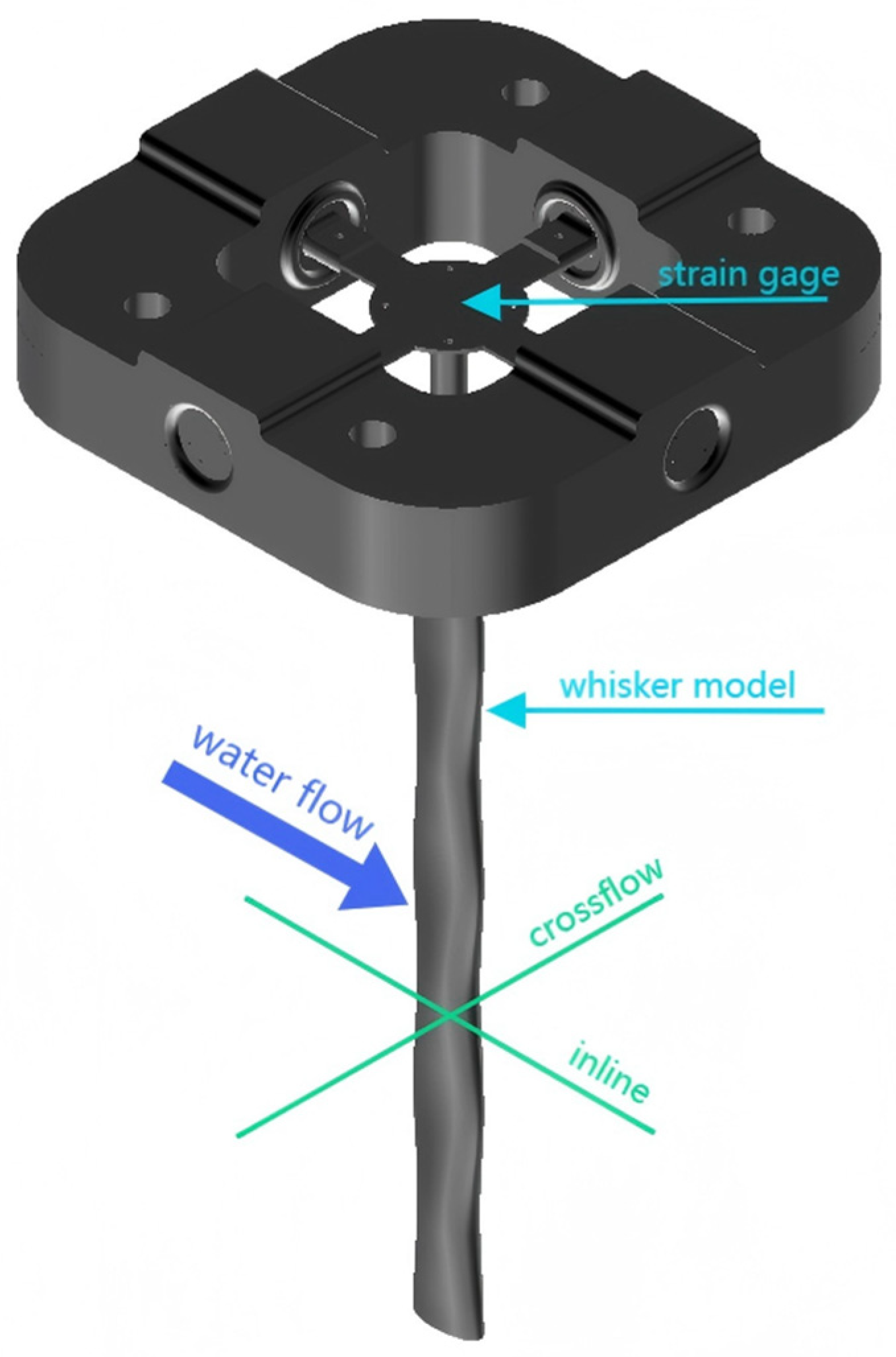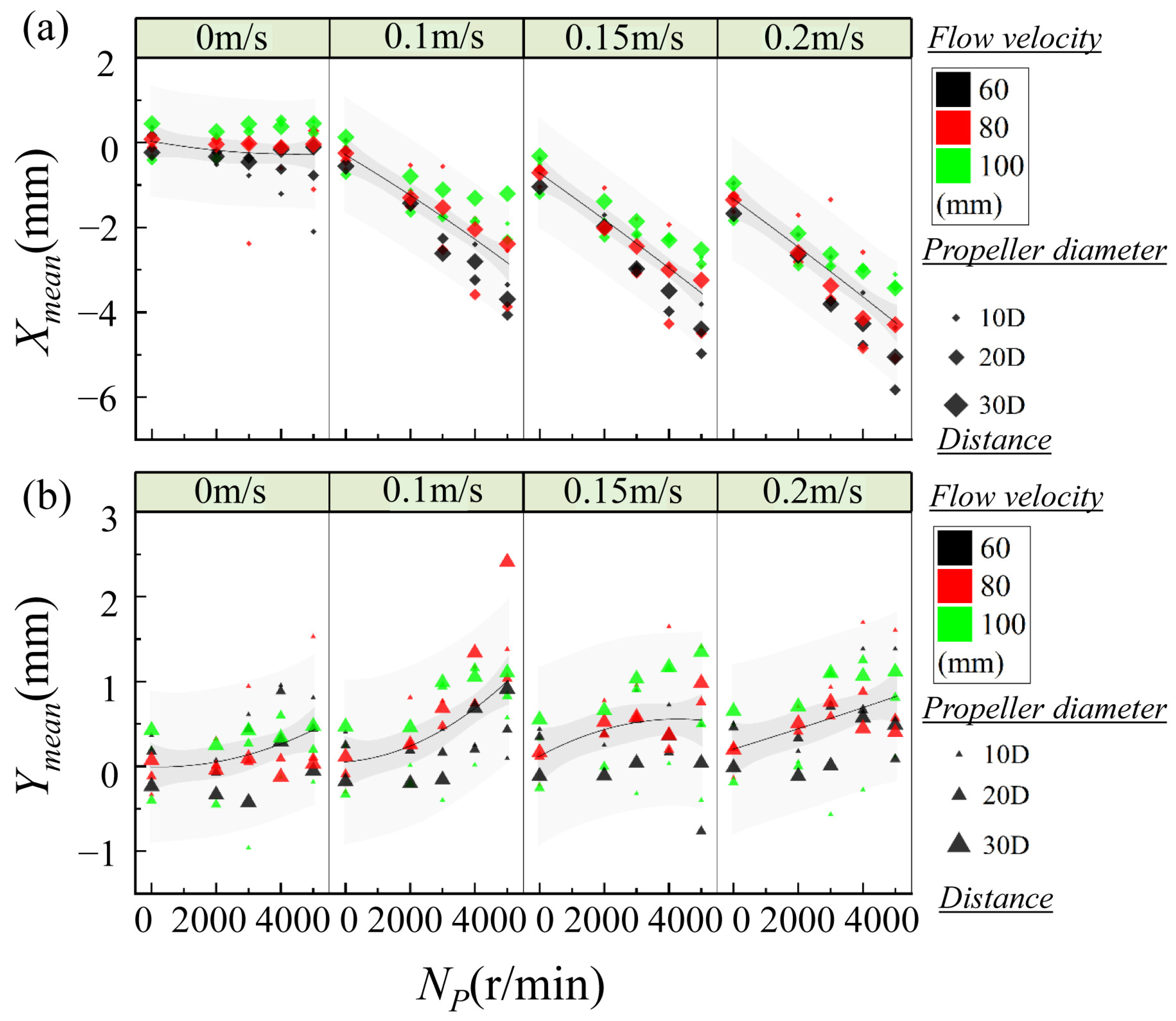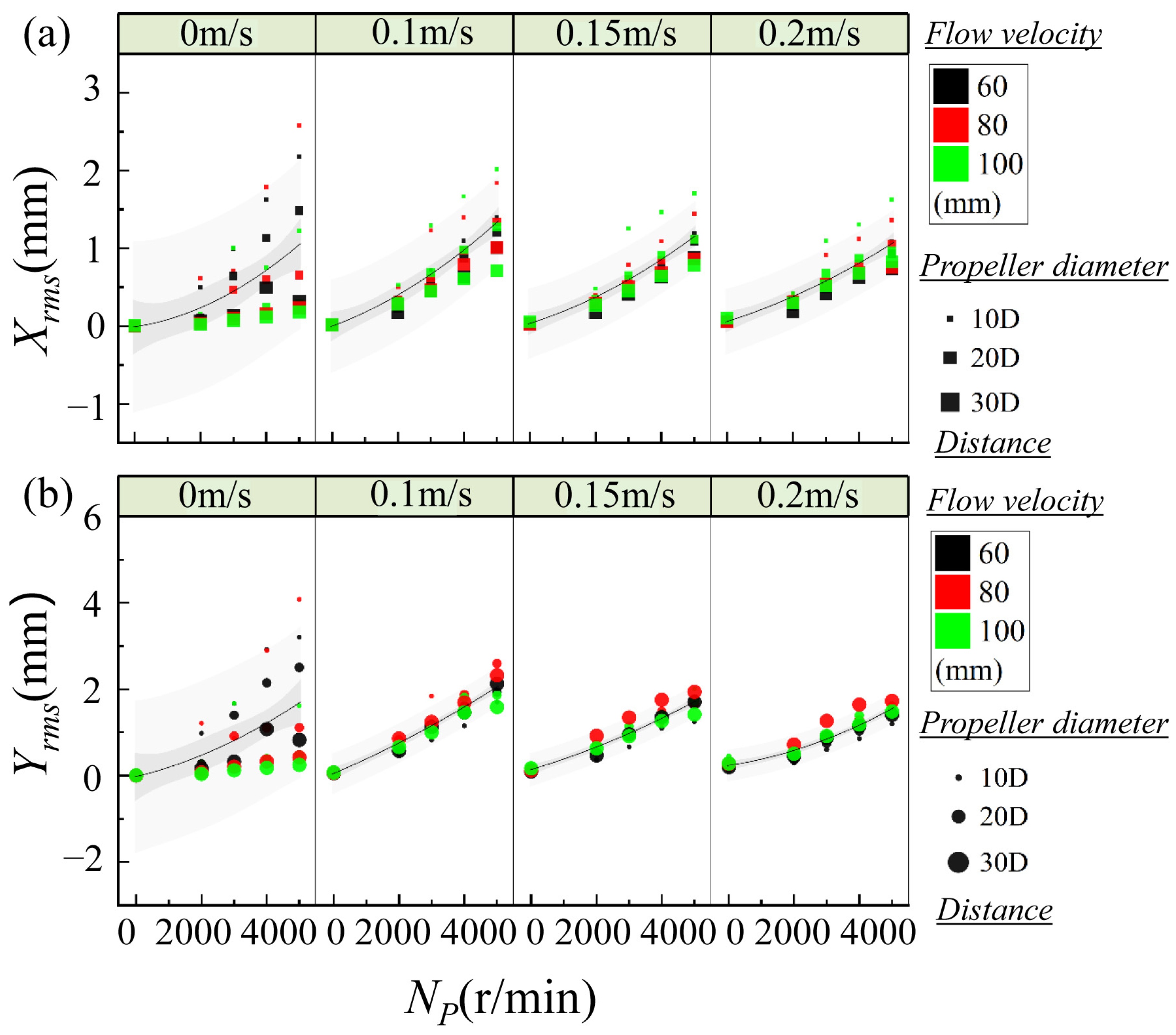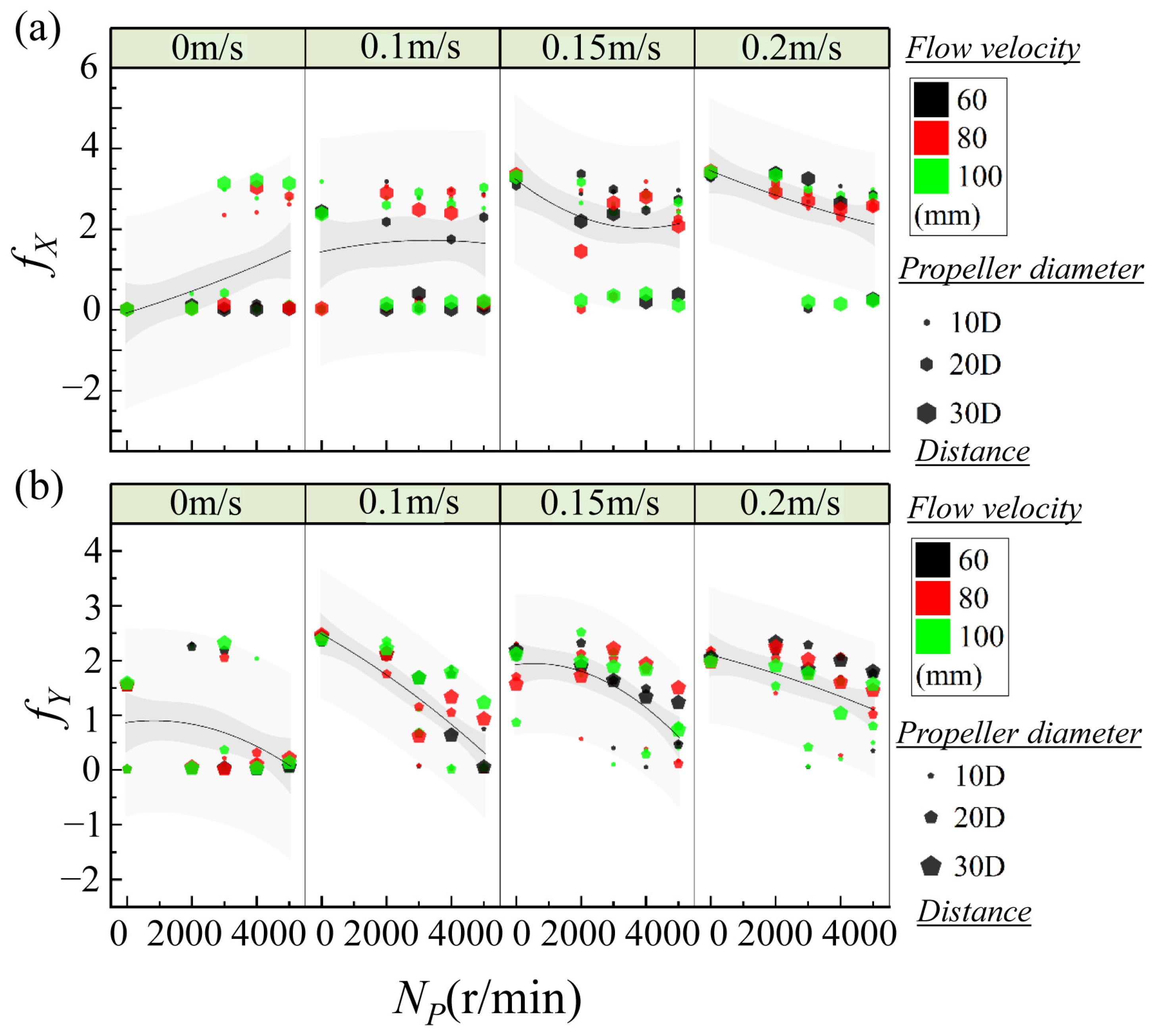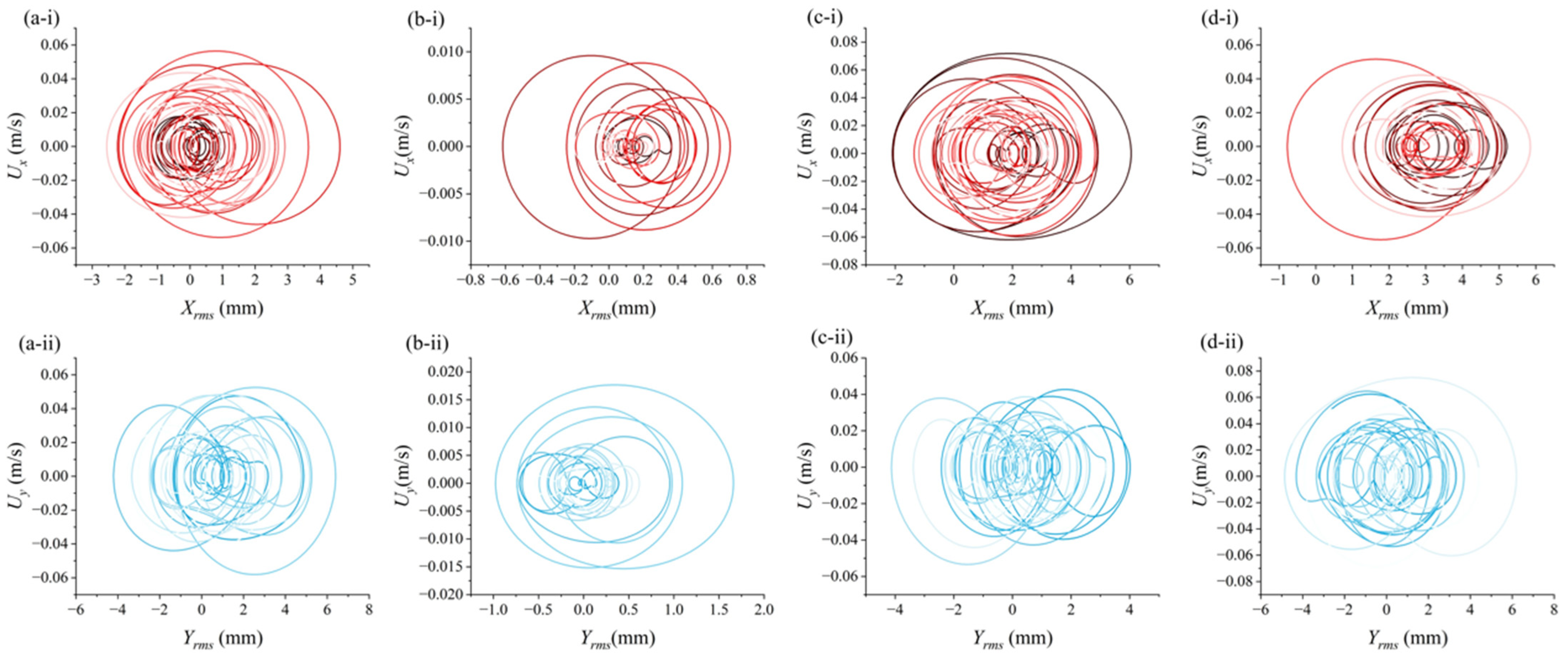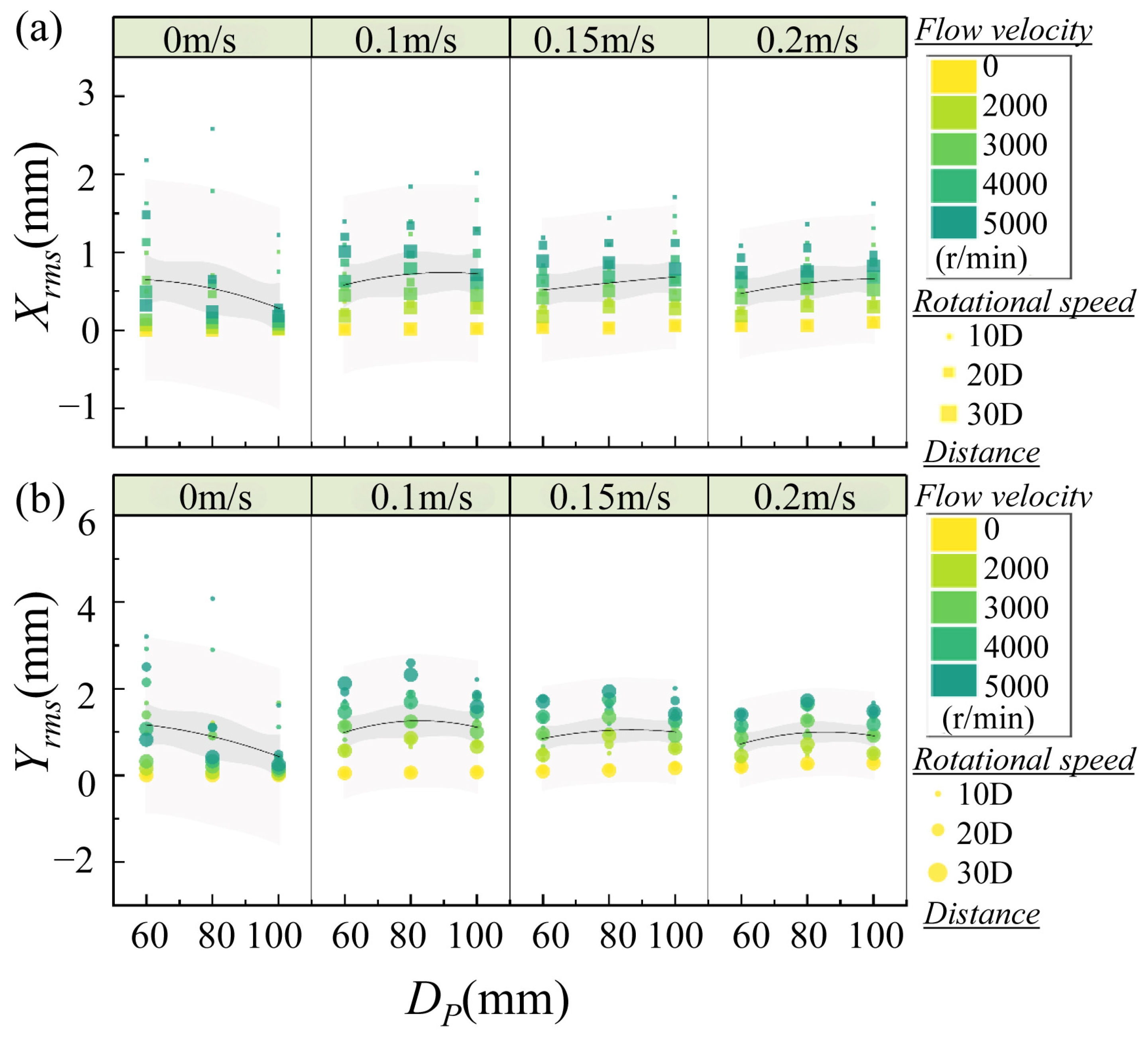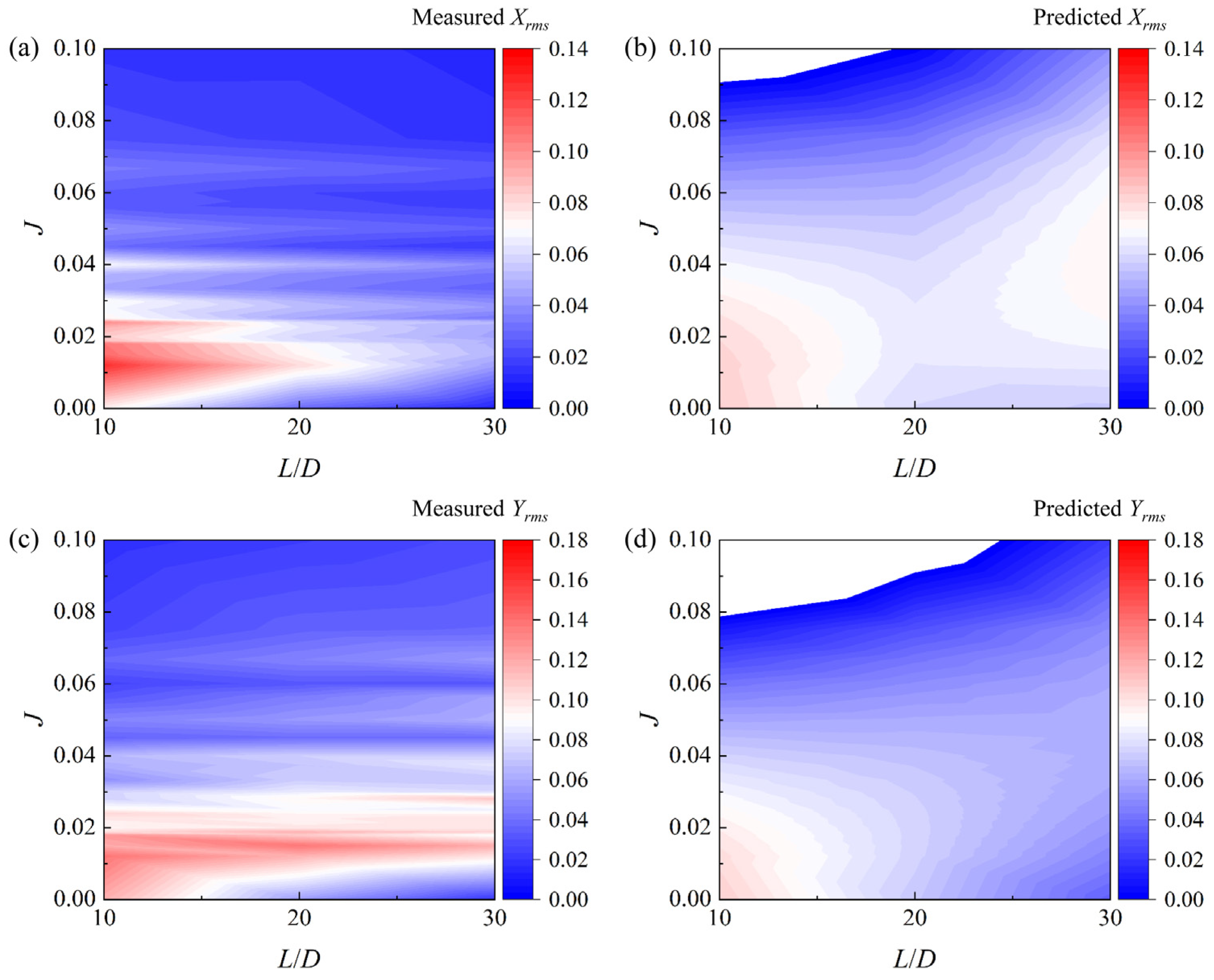To investigate how propeller-induced wake strength modulates the dynamic response of a bio-inspired whisker model, vibration characteristics were analyzed against the propeller rotational speed Np (r/min), propeller diameter Dp (mm), incoming flow velocity U∞ (m/s), and separation distance L/D (D = 16 mm). Six primary response parameters were evaluated—mean crossflow vibration, mean inline vibration, rms of both directions, and corresponding dominant vibration frequencies.
3.1. Propeller Rotational Speed
Figure 5 and
Figure 6 show the mean and rms inline (IL) and crossflow (CF) vibration amplitudes, respectively, as a function of propeller rotational speed (
Np) across different incoming flow velocities (
U∞). The scatter symbols are further indexed by separation distance (symbol size) and propeller diameter (symbol color), enabling an integrated view of parametric influences. At stagnant inflow (
U∞ = 0 m/s), the mean CF amplitude (
Figure 5b) increased steadily from
Np = 2000 to 4000 r/min, rising from near zero to ~0.36 mm, before slightly plateauing beyond 4000 r/min. The mean IL vibration showed a similar monotonic increase, becoming prominent above 3000 r/min (
Figure 5a). This response, although lower in magnitude, suggests the onset of unsteady axial loading. As shown in
Figure 6, rms crossflow vibration rose sharply between 3000 and 4000 r/min, from ~0.01 to nearly 1.0 mm, revealing the threshold where organized wake structures begin to excite the whisker. The rms inline vibration showed a subdued rise but still indicated increasing energy in the inline direction above 3000 r/min. In this condition, without mean flow, wake-induced oscillations of the whisker model are governed primarily by local shear instability and vortex shedding from the rotating blades, as indicated by Di Mascio et al. [
9] and Felli et al. [
10]. In addition, vortex formation is weak and insufficient to induce significant whisker excitation. Above 3000 r/min, coherent tip and hub vortices begin to form helical wake structures strong enough to drive crossflow oscillations [
10]. Inline motion, though weaker, becomes significant as asymmetric suction fields develop near the wake centerline.
As shown in
Figure 5 and
Figure 6, with incoming flow introduced (
U∞ = 0.1 m/s), the effect of the rotational speed on crossflow vibration becomes nonlinear.
Ymean remained stable (~0.3–0.4 mm) until 4000 r/min, then increased slightly at 5000 r/min.
Xmean decreased progressively from ~0 mm at 2000 r/min to ~−1.5 mm at 5000 r/min.
Yrms grew moderately with speed, with a notable step up between 3000–4000 r/min (~0.05 to 1.6 mm).
Xrms was relatively small at lower speeds but increased beyond 4000 r/min. The addition of oncoming flow stretches the helical wake, initially dampening vortex coherence. However, as rotational speed increases, the vortex circulation overcomes convective dissipation. The negative inline mean displacement implies increased downstream pull, likely due to suction from stable vortex cores. At moderate inflow(
U∞ = 0.15 m/s),
Xmean dropped from ~0 to ~−2.0 mm, indicating a stronger suction effect.
Ymean increased strongly across the speed range, from ~0.3 to ~0.6 mm.
Xrms also showed a sharp rise between 3000–4000 r/min (~0.1 to ~1.0 mm).
Yrms rose sharply between 3000–4000 r/min, reaching up to ~1.8 mm. At this moderate inflow, the changes of the whisker response can be attributed to the resonance-like regime as rotational speed induces stronger periodic wake structures. At high inflow velocity condition (
U∞ = 0.2 m/s),
Xmean declined sharply, reaching ~−2.5 mm.
Ymean peaked between 4000–5000 r/min at ~0.7 mm.
Yrms increased up to ~2.0 mm at 4000–5000 r/min.
Xrms followed a similar trend, plateauing near ~1.2 mm. In this high
U∞ condition, the whisker is subjected to rapidly convected, partially destabilized wake structures. Despite reduced interaction time, the magnitude of induced vibrations remains high due to the strength and density of vortex filaments.
While mean and rms vibration amplitudes offer direct evidence of the whisker’s response energy, analyzing the dominant frequency components provides critical insight into the temporal regularity and resonance behavior of the system. The extracted predominant frequencies from crossflow (CF,
fY) and inline (IL,
fX) vibrations reveal how the whisker couples with unsteady vortical structures generated by the propeller wake under various flow conditions, as shown in
Figure 7. As the rotational speed increases from
Np = 2000 to 5000 r/min, a clear upward shift in the dominant frequency of both CF and IL vibrations is observed. For the CF direction, the increase is generally progressive. In contrast, IL frequencies (
fX) show more discrete transitions, often locking into the whisker’s natural frequency (
fnx = 3.3 Hz) or exhibiting subharmonic components (~0.5 ×
fnx), depending on wake stability and coherence. As for the propeller size, larger propeller diameter tends to produce stronger and more coherent tip and hub vortices, as also observed by Felli et al. [
10], which in turn lead to more sharply defined spectral peaks in both CF and IL directions. The frequency associated with larger
Dₚ cases often aligns with either the natural frequencies or subharmonics. Conversely, smaller propellers produce weaker vortices and more distributed frequency content.
In
Figure 7, for the effect of inflow velocity, at
U∞ = 0 m/s,
fY was initially low (~2.3 Hz) and rose to ~2.8 Hz by 5000 r/min.
fX remained near-zero at 2000–3000 r/min, then showed emergence (~3.3 Hz) at 4000–5000 r/min. At
U∞ = 0.1 m/s,
fY increased from ~2.4 to ~3.3 Hz.
fX remained low until 4000 r/min, then increased to ~3.4 Hz at 5000 r/min. At
U∞ = 0.15 m/s,
fY stabilized between 3.3–4.1 Hz.
fX matched that of CF, reaching ~3.8–4.0 Hz. At
U∞ = 0.20 m/s,
fY remained stable near ~4.0–4.3 Hz.
fX increased to ~3.8–4.0 Hz. To gain insight into the dynamic mechanisms underlying wake-induced vibration (WIV), the observed dominant vibration frequencies were compared to the natural frequencies of the whisker model. For line vibration, inline response shows stronger 1.0 ×
fnx lock-in behavior than crossflow (∼23% of cases), implying a more frequent coupling to natural axial oscillation modes. The two 0.5 ×
fnx cases might be linked to global wake pulsations or nonlinear interactions, such as modulation by unsteady blade loading or hub vortex wobble. The broader “Other” category implies that inline vibration is also influenced by nonlinear interactions, possibly including vortex interference and wake reorganization in the near field. For crossflow vibration, only a small subset (~6%) of CF cases show exact resonance (1.0 ×
fny = 2.6 Hz), and another ~9% correspond to subharmonic excitation at ~0.5 ×
fny. The majority (83%) fall outside these harmonic bands, suggesting either frequency modulation due to nonlinear wake forcing or responses to broadband excitation. The sparse resonance cases align with structured helical wake interactions, approximately at moderate speeds and distances. Increasing
U∞ introduces convective transport, stretching the vortex filaments and often destabilizing their periodicity. For example, at low flow (e.g.,
U∞ = 0.10 m/s), lock-in behavior (particularly 1.0 ×
fny) becomes apparent, indicating a favorable synchronization between the wake and the whisker’s natural response. However, at higher flow velocities, frequency peaks tend to broaden and shift slightly upward due to reduced interaction time and vortex fragmentation. For the separation distance (
L/
D) between propeller and whisker model, at smaller
L/
D (e.g., 10–20), higher spectral clarity and stronger resonance with natural modes are observed. As
L/
D increases to 30, both CF and IL frequency spectra become more diffuse, often featuring broadband energy or irregular secondary peaks.
To further explore the evolution and coupling of dominant frequency modes over time, four representative cases were selected based on distinct dynamic transitions observed in both the vibration amplitude and frequency analyses. These cases were strategically chosen to represent key breakpoints in the parameter space: Case 1 (U∞ = 0.00 m/s, Nₚ = 3000 r/min, L/D = 10, Dₚ = 100): Exhibits inline frequency lock-in at 1.0 × fnx in stagnant flow. Ideal for studying wake–whisker coupling in the absence of inflow shear. Case 2 (U∞ = 0.00 m/s, Nₚ = 4000 r/min, L/D = 30, Dₚ = 80): Represents a higher-speed case with longer separation and persistent inline resonance. Highlights effects of spacing on spectral persistence. Case 3 (U∞ = 0.10 m/s, Nₚ = 3000 r/min, L/D = 10, Dₚ = 100): Displays subharmonic CF excitation (0.5 × fny) with strong inline energy, reflecting early-stage vortex pairing in convected wakes. Case 4 (U∞ = 0.10 m/s, Nₚ = 4000 r/min, L/D = 20, Dₚ = 60): Shows subharmonic inline response (0.5 × fnx), possibly indicating slaloming or vortex leapfrogging effects. These cases offer a representative spectrum of behaviors across wake development stages and interaction intensities. Their selection ensures coverage of key response regimes: subharmonic, harmonic (lock-in), and non-resonant behaviors, under both stagnant and flowing conditions. Wavelet transform allows tracking the evolution of dominant frequencies over time, which is particularly valuable for wake-induced vibrations where flow unsteadiness and vortex disintegration can lead to temporal frequency modulation.
Figure 8 presents the time–frequency characteristics of crossflow (CF) and inline (IL) vibrations for four representative cases, as revealed by continuous wavelet transform. Under stagnant flow conditions (
U∞ = 0 m/s), Case 1 (
Np = 3000 r/min,
L/
D = 10,
Dp = 100 mm) shows a temporally stable IL vibration near the natural frequency
fnx = 3.3 Hz, indicating a strong lock-in behavior driven by coherent propeller-induced wake structures. In contrast, the CF component remains broadband and intermittent, suggesting less organized excitation in the transverse direction. As the rotational speed increases in Case 2 (
Np = 4000 r/min) and the whisker is moved further downstream (
L/
D = 30), the IL lock-in at
fnx persists, highlighting the robustness of axial resonance even with partial wake dissipation. Meanwhile, CF vibrations in this case display more structured bursts, possibly due to tip vortex roll-up or weak helical coherence. When low incoming flow is introduced (
U∞ = 0.1 m/s), the spectral characteristics evolve significantly. In Case 3 (
Np = 3000 r/min,
L/
D = 10,
Dp = 100 mm), CF vibrations exhibit dominant frequencies around 1.2–1.5 Hz, corresponding to approximately 0.5 ×
fny. This subharmonic response may result from vortex pairing or leapfrogging, indicative of unsteady wake behavior influenced by mild convective transport. IL vibrations in this case are less sharply defined, with energy dispersed around 2.5–3.0 Hz, pointing to partial lock-in or modulation from time-varying wake forcing. In Case 4 (
Np = 4000 r/min,
L/
D = 20,
Dp = 60 mm), the CF response remains broad but centers around the expected natural range (1.5–3.5 Hz), whereas the IL signal displays subharmonic excitation near 1.5–1.8 Hz—roughly 0.5 ×
fnx. This behavior suggests a transition from resonance-driven response to slaloming-type motion, likely induced by asymmetric vortex impingement or unsteady hub vortex structures.
Taken together, the wavelet spectra confirm that vibration frequency content evolves dynamically across different wake interaction regimes. IL vibrations tend to exhibit resonant lock-in with the natural frequency under stagnant or near-field conditions, while CF vibrations more readily engage in subharmonic or non-resonant responses, especially as inflow velocity and wake complexity increase. These observations reinforce the notion that the whisker model’s sensitivity to vortex dynamics depends not only on amplitude thresholds but also on the temporal coherence and spectral alignment of wake-induced forcing.
To further elucidate the dynamic stability and qualitative nature of the wake-induced vibration (WIV) responses of the whisker model, phase trajectory analysis was conducted for the inline and crossflow motions of in four representative test cases. Phase trajectories are constructed by plotting the displacement response against its time derivative, effectively visualizing the system’s motion in the phase space, as shown in
Figure 9. This approach allows for a qualitative assessment of the vibratory behavior, distinguishing between periodic, quasi-periodic, and chaotic responses. In general, closed and elliptical loops signify stable periodic oscillations; distorted orbits may indicate weak nonlinearity or transition; while irregular, aperiodic patterns are hallmarks of chaotic or turbulent-induced dynamics.
As shown in
Figure 9(ai,bi), the inline (IL) phase trajectories demonstrate a clear progression in system stability. In Case 1, the trajectory forms a tight elliptical loop, indicating a stable and periodic vibration regime where the coherent wake excites a strong yet bounded response. Case 2, with the same inflow condition but increased propeller speed, longer separation, and a smaller propeller, shows a broader and more diffused orbit. This implies a weakened and less coherent wake reaching the whisker, resulting in reduced amplitude and increased phase variability. In Case 3, the trajectory remains closed but becomes slightly asymmetric, reflecting a shift from wake-dominated periodic forcing to flow-mediated modulation. Finally, Case 4 displays a highly irregular and open phase portrait, signaling instability and likely a transition toward chaotic or multi-frequency vibration driven by wake weakening and turbulent background noise.
As shown in
Figure 9(aii–dii), the crossflow (CF) trajectories exhibit a similar evolution. Case 1 again displays a narrow, well-formed loop, characteristic of lock-in with a dominant shedding frequency. In Case 2, the loop expands and loses coherence, consistent with wake decay over longer distances and reduced excitation. Case 3, under moderate inflow, shows a broad but still periodic envelope, whereas Case 4 reveals the most irregular trajectory, suggesting a disordered flow field and reduced wake energy. These patterns align with prior spectral and rms analyses, reinforcing that wake-induced vibration is highly sensitive to both spatial decay and background flow condition, and that phase space mapping provides a clear, qualitative tool to distinguish between coherent, bounded responses and unstable or aperiodic states.
Overall, this phase trajectory assessment confirms that wake coherence and forcing strength diminish with increasing separation and flow complexity, and helps illustrate how vibration stability is modulated across operational conditions even when rms magnitudes alone may not capture such transitions.
3.2. Propeller Diameter
Figure 10 shows the variation in inline and crossflow rms vibration amplitudes of the whisker model with the propeller diameter
Dp, in space of flow velocity (four regions), while scatter size and color reflect spacing and propeller rotational speed, respectively. In quiescent conditions (
U∞ = 0 m/s), both CF and IL vibration amplitudes exhibit a strong decreasing trend with increasing propeller diameter. Specifically, Xrms drops from approximately 0.65 mm at
Dp = 60 mm to around 0.28 mm at
Dp = 100 mm, indicating a significant reduction in axial vibration. This decline suggests that smaller-diameter propellers produce more focused, coherent wake structures that impart stronger excitation to the whisker tip, whereas larger propellers generate more spatially distributed wakes that decay more rapidly over distance. A similar trend is observed in CF vibrations (
Figure 10b), where Yrms diminishes from ~1.17 mm to ~0.44 mm across the same diameter range. Although the overall amplitudes in the CF direction are higher than in the IL direction, the underlying mechanism of reduced wake coherence with larger propeller diameters holds true. These results indicate that, under stagnant flow conditions, smaller propellers generate more effective near-field perturbations that excite both inline and transverse whisker modes. Under stagnant flow (
U∞ = 0 m/s), the pronounced vibration reduction with increasing propeller diameter (
Figure 10) originates from geometric constraints on vorticity generation. Smaller propellers (
Dp = 60 mm) concentrate higher radial velocity gradient near blade tips due to reduced radial distance. This amplifies vorticity flux, forming compact helical vortices that intensify near-field pressure fluctuations and elevate RMS amplitudes (
Yrms = 1.17 mm at
Dp = 60 mm). Conversely, larger propellers (
Dp = 100 mm) dissipate vorticity through vortex stretching and viscous diffusion, attenuating forcing by >60%.
In the presence of a low incoming flow (
U∞ = 0.1 m/s), for IL vibrations (
Figure 10a), the
Xrms exhibits a non-monotonic pattern: increasing from ~0.58 mm at
Dp = 60 mm to a peak of ~0.72 mm at
Dp = 80 mm. This suggests the emergence of resonance-like conditions where the interaction between convected vortices and the whisker’s natural frequency is maximized at intermediate diameters. At these diameters, the wake may remain sufficiently coherent to impose periodic forcing in alignment with the whisker’s dynamic response. A corresponding non-monotonic trend is also evident in CF vibrations (
Figure 10b), where
Yrms rises from ~0.99 mm to ~1.26 mm at
Dp = 80 mm. The increase points to a potential lock-in or constructive interference mechanism between the propeller-induced wake and the whisker’s transverse modes.
At U∞ = 0.15 m/s, IL vibration amplitudes remain relatively close among the changes of Dp = 60–100 mm. CF vibrations display a sharper transition. Yrms initially rises to ~1.1 mm at Dp = 80 mm and then drops sharply to ~0.47 mm at Dp = 100 mm. This abrupt drop suggests that increasing Dp beyond a threshold causes wake disorganization or phase dispersion, which inhibits coherent vortex impingement on the whisker tip. Similar trends for the IL and CF vibrations are also observed at U∞ = 0.20 m/s. In general, propeller diameter influences rms vibration amplitude in both the IL and CF directions through a combination of wake coherence, spatial structure, and interaction with background flow. While stagnant conditions favor reduced vibration with increasing diameter, the presence of a weak incoming flow introduces a non-monotonic behavior—most notably in the inline response—suggesting enhanced resonance at intermediate diameters.
3.3. Inflow Velocity
Figure 11a,b show the evolution of inline (IL) and crossflow (CF) rms vibration amplitudes, respectively, as a function of incoming flow velocity (
U∞), classified across distinct propeller rotational speeds (
Np = 0 to 5000 r/min). The marker size and color encode separation distance (
L/
D) and propeller diameter (
Dp), respectively. At
Np = 0 r/min (no propeller rotation), both
Xrms and
Yrms amplitudes increase steadily with increasing
U∞. This reflects the classical behavior of bluff bodies in uniform flow, where vortex-induced vibrations intensify with Reynolds number. CF vibrations grow from ~0.006 mm at
U∞ = 0 to ~0.26 mm at
U∞ = 0.20 m/s, while IL amplitudes rise more gradually. The magnitude of CF responses far exceeds IL, consistent with the typical dominance of transverse excitation in vortex shedding processes. When the propeller is activated (
Np ≥ 2000 r/min), a pronounced amplification of vibration occurs at all flow velocities. For example, at
Np = 2000 r/min,
Xrms increases from ~0.18 mm (
U∞ = 0.00 m/s) to ~0.42 mm (
U∞ = 0.20 m/s), while
Yrms increases from ~0.37 mm to ~0.83 mm over the same
U∞ range. This enhancement is due to superposition between the natural VIV mechanism and unsteady wake structures generated by the rotating blades, particularly tip and hub vortices [
9], which provide persistent excitation across both vibration directions.
In
Figure 11, at higher rotational speeds (
Np = 3000–5000 r/min), the IL and CF vibration levels increase even more substantially, particularly at moderate inflow velocities (
U∞ = 0.10–0.15 m/s). This may reflect the optimal synchronization between the convected propeller wake frequency and the natural frequencies of the whisker model. Under these conditions, lock-in phenomena or resonance can occur, leading to peak rms amplitudes. Beyond
U∞ ≈ 0.15–0.20 m/s, however, the growth in vibration amplitude appears to plateau or slightly decrease for some configurations, likely due to wake dispersion and background turbulence disrupting coherence and reducing effective forcing.
Across all propeller speeds, larger propeller diameters (color scale) generally correlate with slightly reduced vibration amplitudes, especially at higher U∞, likely due to broader and less concentrated wake structures. In summary, rms vibration amplitudes in both IL and CF directions generally increase with incoming flow velocity, but the magnitude and growth trend are strongly modulated by propeller rotational speed. The coupling between background flow, wake coherence, and structural resonance governs the strength and nature of whisker excitation.
3.5. Correlation and Sensitivity Analysis
To quantitatively evaluate the influence of each input parameter—propeller rotational speed (
Np), diameter (
Dp), inflow velocity (
U∞), and separation distance (
L/
D)—on the whisker vibration characteristics, a Pearson correlation (
r) matrix analysis was performed, as shown in
Figure 13. The response variables included the inline (IL) and crossflow (CF) root-mean-square (
rms) amplitudes and mean displacements. As shown in
Figure 13, the correlation matrix reveals distinct trends: Inflow velocity (
U∞) shows the strongest positive correlation with
Yrms (
r = +0.74) and a substantial correlation with
Xrms (
r = +0.62), confirming its primary role in enhancing wake convection and vortex–structure interaction. Propeller rotational speed (
Np) also strongly correlates with
Xrms (
r = +0.66) and
Yrms (
r = +0.63), indicating that higher tip vortex intensity reinforces vibration amplitudes. Separation distance (
L/
D) exhibits a negative correlation with both
Xrms (
r = −0.68) and
Yrms (
r = −0.59), reflecting the wake energy decay and loss of coherence with increasing downstream distance. Propeller diameter (
Dp) shows a relatively weaker and slightly negative correlation, particularly with
Yrms (
r = −0.31), suggesting that larger diameters may diffuse wake structures and reduce localized forcing on the whisker tip. These results quantitatively support the physical interpretations drawn from earlier visual analyses. The dominant role of rotational speed and inflow velocity across both IL and CF directions highlights their fundamental importance in shaping wake–structure interaction strength. Meanwhile, the consistently negative impact of separation distance confirms its spatial filtering effect on wake energy transfer.
The correlation matrix also revealed that the propeller rotational speed (
Np), diameter (
Dp), inflow velocity (
U∞) are not only related to vibration responses, but they are also interdependent, which can be reflected as the key non-dimensional parameter advance ratio (
J = U∞/
(NpDp)) [
11]. Physically, the advance ratio
J governs the interplay between convective inflow and propeller-induced rotation. At low
J: Propeller rotation dominates, producing tight-pitch helical wakes with strong coherence. This favors resonance when wake frequencies align with whisker natural frequencies (e.g., lock-in observed in
Figure 8). At high
J: Inflow convection stretches and destabilizes vortices, reducing energy transfer via shortened interaction time and increased phase incoherence. Simultaneously, the separation distance
L/
D (with
D being the whisker diameter) also demonstrated a moderate negative correlation, suggesting a spatial attenuation of wake coherence with downstream distance. These two parameters were thus selected to construct a physically interpretable response surface with the whisker model’s vibrations. As such, a polynomial surface was selected to capture not only the linear but also the interaction and curvature effects between these key non-dimensional quantities.
The fitting process was based on the least squares method, wherein the model minimizes the total squared error between the predicted and measured vibration responses. The independent variables were mapped into a second-order polynomial basis: [
L/
D,
J, (
L/
D)
2,
J2, (
L/
D) ×
J], allowing for physical interpretability while avoiding overfitting. Separate regression models were established for inline and crossflow rms amplitudes. The resulting empirical relationships are as follows:
These expressions (1–2) reveal several key insights. First, the negative coefficients for both J and J2 confirm that as the advance ratio increases (i.e., when convective inflow dominates over rotational effects), the vibratory excitation imposed on the whisker structure diminishes significantly. Second, the negative influence of L/D affirms that increased downstream distance leads to attenuation of the wake-induced forces. Interestingly, the positive interaction terms (L/D) × J suggest that wake coherence may still be retained under certain flow-separation combinations, resulting in localized amplification zones. The small positive coefficient for (L/D)2 in the crossflow case (~10−5) indicates a very mild curvature effect, likely attributable to long-range wake diffusion. Model performance was also evaluated using the coefficient of determination R2, yielding 0.465 for inline and 0.302 for crossflow rms amplitudes, respectively. These values indicate that the polynomial models capture approximately 47% and 30% of the observed variance—reasonable considering the complexity of three-dimensional wake-structure interactions and the simplifying assumption of a second-order response surface. In principle, this form may be applied to other propeller geometries or bio-inspired sensors, provided the flow remains dominated by coherent unsteady forcing (e.g., vortex shedding or helical wakes). However, different propeller designs (e.g., blade number, pitch, hub effects) or flow environments (e.g., stratified, pulsatile, or turbulent inflow) may introduce additional parameters that influence the vibration response. As such, recalibration using experimental or numerical data would be necessary for broader generalization.
To visually assess model fidelity and local prediction accuracy, contour plots were constructed for both measured and predicted values across the parametric space defined by
L/
D and
J, as shown in
Figure 14. The measured inline vibration amplitude distribution (
Figure 14a) is generally well reconstructed by the predicted surface (
Figure 14b), particularly in regions with low
J and small separation distance, where wake coherence and forcing strength are highest. In contrast, regions at high
J and large
L/
D show some discrepancy, indicating underprediction due to low-frequency, low-magnitude vibrations that approach the noise floor. A similar pattern is observed for the crossflow response (
Figure 14c,d), albeit with slightly reduced accuracy, consistent with the lower
R2 value. These plots demonstrate the predictive reliability of the model within the operational regime of strong wake interaction, while also delineating zones where physical effects may be more complex or dominated by other unmodeled factors such as turbulence intensity or wake asymmetry. Overall, the fitted non-dimensional models provide a compact yet informative representation of whisker response behavior under propeller-induced wake forcing, offering a foundation for parameter sensitivity diagnostics, operational prediction, and bio-inspired sensor design optimization.

